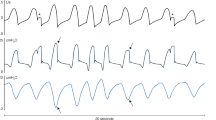Abstract
Assessment of effective ventilation in neonatal mask ventilation can be difficult. This study aims to determine whether manual ventilation with a T-piece resuscitator containing an inline CO2 detector (either a Pedi-Cap® CO2 detector or a Neo-StatCO2 <Kg® CO2 detector connected to a facemask) facilitates effective positive pressure ventilation compared to no device in a mannequin study. Paediatric and neonatal trainees were randomly assigned to determine which method they began with (no device, Pedi-Cap or a Neo-Stat). The participants used each method for a period of 3 min. They were video-recorded to determine the amount of effective ventilations delivered and the overall percentage efficiency of each method. Efficacy of ventilation was determined by comparing the number of manual ventilations delivered with the number of times chest rise was observed in the video recording. There were 19 paediatric trainees who provided a total of 7,790 ventilations, and 93% were deemed effective. The percentage of effective ventilations with the T-piece resuscitator alone, the PediCap and the NeoStat were 90, 94 and 96%, respectively. The difference was greatest in the first minute (T-piece resuscitator alone 87.5%, PediCap 94%, NeoStat 96%). Two thirds preferred the Neo-Stat. The use of a CO2 detector improves positive pressure ventilation in a mannequin model, especially in the first minute of positive pressure ventilation. The Neo-Stat CO2 detector was the preferred device by the majority of the participants.



Similar content being viewed by others
Abbreviations
- NRP:
-
Neonatal Resuscitation Program
- IPPV:
-
Intermittent positive pressure ventilation
- ETT:
-
Endotracheal tube
- CUMH:
-
Cork University Maternity Hospital
- HORIZ:
-
Horizontally attached CO2 detector
- VERT:
-
Vertically attached CO2 detector
- TPR:
-
T-piece resuscitator
- SHO:
-
Senior House Officer
References
Aziz HF, Martin JB, Moore JJ (1999) The pediatric disposable end-tidal carbon dioxide detector role in endotracheal intubation in newborns. J Perinatol 19:110–113
Boo NY (2009) Neonatal resuscitation programme in Malaysia: an eight-year experience. Singap Med J 50:152–159
Duran R, Aladag N, Vatansever U, Sut N, Acunas B (2008) The impact of Neonatal Resuscitation Program courses on mortality and morbidity of newborn infants with perinatal asphyxia. Brain Dev 30:43–46
Finer NN, Rich W, Wang C, Leone T (2009) Airway obstruction during mask ventilation of very low birth weight infants during neonatal resuscitation. Pediatrics 123:865–869
Garey DM, Ward R, Rich W, Heldt G, Leone T, Finer NN (2008) Tidal volume threshold for colorimetric carbon dioxide detectors available for use in neonates. Pediatrics 121:1524–1527
Kamlin CO, O'Donnell CP, Davis PG, Morley CJ (2005) Colorimetric end-tidal carbon dioxide detectors in the delivery room: strengths and limitations. A case report. J Pediatr 147:547–548
Kattwinkel J (2011) Textbook of neonatal resuscitation, 6th edn. American Heart Association, American Academy of Paediatrics
Kattwinkel J, Perlman JM, Aziz K, Colby C, Fairchild K, Gallagher J, Hazinski MF, Halamek LP, Kumar P, Little G, McGowan JE, Nightengale B, Ramirez MM, Ringer S, Simon WM, Weiner GM, Wyckoff M, Zaichkin J (2010) Special report—neonatal resuscitation: 2010 American Heart Association guidelines for cardiopulmonary resuscitation and emergency cardiovascular care. Pediatrics 2972E: e1400–e1413
Leone TA, Lange A, Rich W, Finer NN (2006) Disposable colorimetric carbon dioxide detector use as an indicator of a patent airway during noninvasive mask ventilation. Pediatrics 118:e202–e204
Levitan RM, Vanderbeek P, Kuhfahl K (2009) Performance failure of a colorimetric end-tidal CO2 detector. Ann Emerg Med 54:636–637
O'Donnell CP, Davis PG, Lau R, Dargaville PA, Doyle LW, Morley CJ (2005) Neonatal resuscitation 2: an evaluation of manual ventilation devices and face masks. Arch Dis Child Fetal Neonatal Ed 90:F392–F396
Patel D, Piotrowski ZH (2002) Positive changes among very low birth weight infant Apgar scores that are associated with the neonatal resuscitation program in Illinois. J Perinatol 22:386–390
Schmolzer GM, Dawson JA, Kamlin CO, O'Donnell CP, Morley CJ, Davis PG (2011) Airway obstruction and gas leak during mask ventilation of preterm infants in the delivery room. Arch Dis Child Fetal Neonatal Ed 96:254–257
Schmolzer GM, Poulton DA, Dawson JA, Kamlin CO, Morley CJ, Davis PG (2010) Assessment of flow waves and colorimetric CO2 detector for endotracheal tube placement during neonatal resuscitation. Resuscitation 82:307–312
Zhu XY, Fang HQ, Zeng SP, Li YM, Shi SZ (1997) The impact of the Neonatal Resuscitation Program Guidelines (NRPG) on the neonatal mortality in a hospital in Zhuhai, China. Singap Med J 38:485–487
Contributorship
Gavin Anthony Hawkes had primary responsibility for overall content and manuscript preparation. He was also involved with study design, data collection and data interpretation. Brian O'Connell was involved with mannequin design and maintenance of all devices used in the study. Vicki Livingstone was involved with the statistical analysis carried out in the study. Colin Hawkes was involved with study design and manuscript preparation. C. Anthony Ryan was involved with study design, data analysis and manuscript preparation. Eugene Michael Dempsey was the supervisor for this study. He was involved with overall content, study design, manuscript preparation, data collection and data interpretation.
Conflicts of interest
The authors of this study do not have any conflicts of interest to disclose.
Author information
Authors and Affiliations
Corresponding author
Rights and permissions
About this article
Cite this article
Hawkes, G.A., O’Connell, B.J., Livingstone, V. et al. Efficacy and user preference of two CO2 detectors in an infant mannequin randomized crossover trial. Eur J Pediatr 172, 1393–1399 (2013). https://doi.org/10.1007/s00431-013-2057-9
Received:
Accepted:
Published:
Issue Date:
DOI: https://doi.org/10.1007/s00431-013-2057-9




